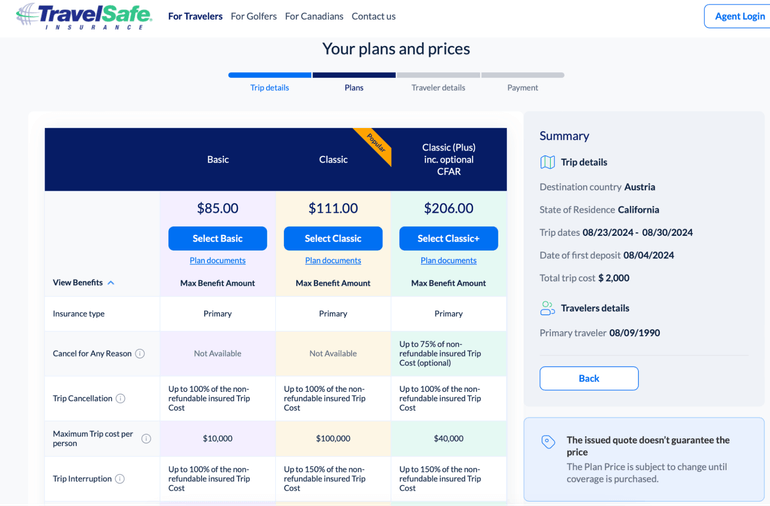TravelSafe Insurance Review: Is It Worth the Cost?
TravelSafe offers two tiers of coverage — compare these to the coverage your travel credit card provides before deciding.

Many or all of the products on this page are from partners who compensate us when you click to or take an action on their website, but this does not influence our evaluations or ratings. Our opinions are our own.
Table of Contents

TravelSafe
Pros
- Covers up to $300 redepositing points and miles on eligible canceled award flights.
- Optional add-on protection for business equipment or sports rentals.
Cons
- Multi-trip or year-long plans aren’t available.

TravelSafe
Pros
- Covers up to $300 redepositing points and miles on eligible canceled award flights.
- Optional add-on protection for business equipment or sports rentals.
Cons
- Multi-trip or year-long plans aren’t available.
Are you wondering whether to buy travel insurance? There are a ton of companies out there offering protection from unexpected events like illness, flight cancellations and lost baggage. TravelSafe insurance is one such provider — it features a range of protections to give you peace of mind when on the road. It’s one of the most expensive travel insurance companies, but it offers protection that you don’t usually find elsewhere.
Why trust NerdWallet?
Our Nerdy editorial team aims to be a starting point in your travel insurance research. We default toward transparency and follow a comprehensive methodology for rating and reviewing travel insurance companies. Advertisers and advertising relationships do not influence our ratings. Learn more about our strict editorial guidelines.
What is TravelSafe?
Unlike many other travel insurance companies, TravelSafe is privately owned. TravelSafe has just two plans from which to choose, so it may seem like your options are limited, but that’s far from the case. TravelSafe’s travel insurance policies are wholly comprehensive and provide coverage for mishaps you won’t find elsewhere.
TravelSafe’s policies are underwritten by United States Fire Insurance Co., which holds an AM Best rating of A (excellent).
What does TravelSafe cover?
TravelSafe travel insurance coverage is better than what you’ll find at many other companies. You’ll find the standard TravelSafe travel insurance medical coverage and trip cancellation coverage but also much more:
TravelSafe health insurance coverage: Covers accident or injury that occurs during your travels.
Trip cancellation and trip interruption: Repays you for nonrefundable costs incurred in the event your trip is canceled or interrupted for a covered reason.
Emergency evacuation and repatriation: Reimburses the cost of a medical evacuation or the repatriation of remains back to your home country.
Luggage insurance: Offers protection and reimbursement in the event your luggage is delayed, damaged or lost.
Frequent traveler reward insurance: Reimburses the costs for redepositing frequent flyer rewards back into your account in the event you need to change or cancel your plans.
Missed connection insurance: Helps cover the costs of a new flight if you miss your connection.
TravelSafe policies
There are two travel insurance policies available from TravelSafe:
Trip cancellation | Trip interruption | Medical coverage | Luggage | |
|---|---|---|---|---|
Basic | Up to 100% of trip cost. | Up to 100% of trip cost. | Up to $35,000. | Up to $100 for delay, up to $500 for lost luggage. |
Classic | Up to 100% of trip cost. | Up to 150% of trip cost. | Up to $100,000. | Up to $250 for delay, up to $2,500 for lost luggage. |
Add-on options
Because TravelSafe’s plans are already comprehensive, there isn’t much to add on. Your only option is to include Cancel For Any Reason (CFAR) insurance.
What’s not covered by a TravelSafe plan
While TravelSafe provides excellent coverage to travelers, there are some situations in which your plan won’t apply. These include:
Anything that happens under the influence of drugs and alcohol.
Epidemics.
Storms after they’ve already been named.
Participation in athletic events.
How TravelSafe compares to its competitors
On a five-star scale, NerdWallet rated TravelSafe four stars. While there are a few competitors that scored higher, including Berkshire Hathaway, Trawick, WorldTrips and Arch RoamRight, TravelSafe is still among the best we’ve reviewed.
Company | Star rating | Basic plan cost | Premium plan cost | Generate a quote |
|---|---|---|---|---|
GeoBlue Travel Insurance | 4.5 NerdWallet rating | $10. | $18. | |
Berkshire Hathaway Travel Protection | 5.0 NerdWallet rating | $26. | $75. | |
Tin Leg | 3.0 NerdWallet rating | $36. | $188. | |
WorldTrips Travel Insurance | 5.0 NerdWallet rating | $47. | $66. | |
World Nomads | Currently being rated and reviewed. | $63. | $115. | |
Trawick International | 5.0 NerdWallet rating | $100. | $194. | |
AXA Assistance USA | 1.5 NerdWallet rating | $114. | $159. | |
Generali | 1.5 NerdWallet rating | $123. | $164. | |
Travelex Insurance Services | 4.0 NerdWallet rating | $135. | $198. | |
AEGIS (GoReady) Travel Insurance | 3.5 NerdWallet rating | $139. | $208. | |
HTH Travel Insurance | 4.0 NerdWallet rating | $146. | $233. | |
Seven Corners | 3.0 NerdWallet rating | $154. | $225. | |
Travel Insured International | 4.0 NerdWallet rating | $164. | $218. | |
Allianz Global Assistance | 3.5 NerdWallet rating | $166. | $291. | |
USI Affinity Travel Insurance Services | 1.0 NerdWallet rating | $169. | $297. | |
AAA | Currently being rated and reviewed. | $183. | $222. | |
IMG | 3.5 NerdWallet rating | $183. | $252. | |
Travel Guard by AIG | Currently being rated and reviewed. | $135. | $236. | |
Chubb | 1.0 NerdWallet rating | $185. | $312. | |
TravelSafe | 4.0 NerdWallet rating | $200. | $468. | |
Arch RoamRight | 4.5 NerdWallet rating | $202. | $225. | |
These star ratings are based on a separate analysis of each travel insurance provider’s offerings. For more detailed scoring, see our recommendations for the best travel insurance companies, read each individual provider's NerdWallet review or view our methodology at the end of this article. Pricing is subject to change based on your specific trip details. You can verify the latest price by clicking through to Squaremouth (a NerdWallet partner). | ||||
How much is TravelSafe travel insurance?
How much does TravelSafe travel insurance cost? A sample trip for a 36-year-old traveler from Indiana to Canada for five days found that the cheapest TravelSafe plan cost $200. If you were to spring for the premium plan, which includes CFAR coverage, expect to pay $468.
Other providers charged anywhere from $10 to $202 for their basic plan for the same sample trip. Note that price isn't the only differentiating factor. Travel insurance cost and coverage are not identical across plans; each company offers various levels of scope, limits and exclusions.
How to buy a TravelSafe policy
Purchasing a TravelSafe insurance policy is simple and can be done online. To do so, you’ll first want to head to TravelSafe’s website.
From there, you’ll be able to generate a quote for your trip based on where you live, where you’re going, when you’re traveling and other important details.
TravelSafe will then show you a comparison of available plans, including their cost and their coverage levels.

Once you select a plan, you’ll be taken through the checkout process. After you’ve purchased the plan — you’re covered! It’s as easy as that.
Consider comparison shopping
If you're not 100% sold on purchasing a plan from TravelSafe, you can use a travel insurance aggregator to compare policies across multiple companies at once.
Which TravelSafe travel insurance plan is best for me?
Finding a TravelSafe plan that suits your needs is not complicated. Since there are only two plans available to travelers, you’ll just need to choose the one whose coverage fits your expenses.
For example, if you’re worried about becoming injured or ill during your journey, you may want to opt for the more expensive Classic plan because its emergency medical coverage limit is much higher than that of the Basic plan.
Does TravelSafe offer 24/7 travel assistance?
Yes, TravelSafe offers 24/7 travel assistance for all of its customers. Your best bet is to call:
Toll-free: 866-509-7713.
Collect: 603-952-2047.
How to file a claim with TravelSafe travel insurance
To file a claim with your TravelSafe policy, you have two options. The first is to file online via TravelSafe’s self-service claim portal. Otherwise you can call to make a claim:
Toll-free (U.S. only): 877-539-6729.
Direct: 727-475-2808.
Is TravelSafe travel insurance worth it?
Is TravelSafe travel insurance good? TravelSafe insurance is among the most expensive travel insurance you can buy, but it’s for a good reason. Its coverage includes all the standard protections you’d expect, as well as some you might not. If you’re looking only for minimal coverage, you may want to search elsewhere — but if you have specialty circumstances, such as having redeemed rewards for your trip, you may want to consider purchasing a TravelSafe policy.
TravelSafe review recapped
TravelSafe’s two travel insurance plans offer comprehensive coverage for when you’re away from home. Compare the benefits of both before deciding on a purchase — and be sure to double-check whether you already have existing coverage from a travel credit card.
Star rating methodology
How to maximize your rewards
You want a travel credit card that prioritizes what’s important to you. Here are some of the best travel credit cards of 2025:
Flexibility, point transfers and a large bonus: Chase Sapphire Preferred® Card
No annual fee: Wells Fargo Autograph® Card
Flat-rate travel rewards: Capital One Venture Rewards Credit Card
Bonus travel rewards and high-end perks: Chase Sapphire Reserve®
Luxury perks: The Platinum Card® from American Express
Business travelers: Ink Business Preferred® Credit Card
Chase Sapphire Preferred® Card
Travel
Dining
🔥 Huge highest-ever bonus on NerdWallet's 2025 Best All-Purpose Travel Rewards Card is back. Don't miss your rare chance to: Earn 100,000 points when you spend $5,000 on purchases in the first three months. That's worth at least $1,250 toward travel booked through Chase.


